#Radial Magnets
Explore tagged Tumblr posts
Text
youtube
Powerful Performance: Testing a 5KW 500RPM 220VAC Single Phase PMG by J.D. Engineering Works
Welcome to J.D. Engineering Works! In this exciting video, we show you the powerful performance of our 5KW 500RPM 220VAC Single Phase Permanent Magnet Generator (PMG).
Our dedicated team of engineers has put their expertise into creating a high-performance generator that pushes the boundaries of single-phase power generation. In this video, we are showing you the highest standards of quality and reliability of the 5KW 500RPM 220VAC Single Phase Permanent Magnet Generator (PMG). . As we fire up the 5KW PMG, you'll be amazed by its steady 500RPM rotation, producing a clean and stable 220VAC output. The consistent power generation capabilities of our Permanent Magnet Generator (PMG) make it an ideal choice for various applications, from off-grid setups and backup power solutions to integration with renewable energy systems.
Our team at J.D. Engineering Works is committed to sustainability and renewable energy solutions, and this Permanent Magnet Generator (PMG) exemplifies our dedication to delivering cutting-edge technology that drives the future of green power.
Don't forget to like, share, and subscribe to our channel for more exciting updates on our latest innovations and projects.
Thank you for being part of our journey towards a greener and more sustainable tomorrow. Together, let's power the world with clean energy solutions from J.D. Engineering Works.
For any queries regarding 5KW 500RPM 220VAC Single Phase Permanent Magnet Generator (PMG), email us at [email protected], or Call or WhatsApp at +919582345931, +919289311243, +918851614166, +919999467601.
#permanent magnet generator#low rpm permanent magnet generator#axial flux permanent magnet generator#radial flux permanent magnet generator#generator manufacturer#permanent magnet generator manufacturer#permanent magnet generator manufacturer in India#permanent magnet generator manufacturer in Delhi#permanent magnet synchronous generator#permanent magnet alternator#permanent magnet alternator manufacturer in India#permanent magnet alternator manufacturer in Delhi#low rpm permanent magnet alternator#permanent magnet low rpm alternator#permanent magnet alternator manufacturers#high speed permanent magnet alternators#Youtube
2 notes
·
View notes
Text
NdFeB Motor Magnets Supplier
NdFeB Motor Magnets Supplier – HSMAG Our engineered neodymium magnets unlock new possibilities for high-efficiency motor design. With unmatched magnetic energy density, these customizable magnets advance electric motor performance through compact form factors, quiet operation, fast response times, and excellent speed control. Leveraging decades of experience, we expertly craft neodymium magnet…
#elevator magnets#elevator traction motors#Laminated Motor Magnets#Linear Motor Magnets#magnet manufacturers#magnetic generators#magnetic tractors#Motor Magnets#Motors and generators#Neodymium magnets#neodymium ring motor magnets#Permanent Magnet Motors#Radial Ring Magnets#rare earth neodymium magnets#servo motor magnets#Sintered Neodymium Magnets#Tubular Linear Motor Magnets#Voice Coil Motor Magnets
0 notes
Text
Axial Flux Motor vs. Radial Flux Motor
Axial Flux Motor vs. Radial Flux Motor Axial flux and radial flux motors are two common motor types with distinct designs and characteristics. Each has advantages that make it suitable for different applications, from automotive to industrial uses. Here’s an in-depth comparison of their construction, performance, and ideal use cases. 1. Design and Construction – Axial Flux Motor: In an axial flux…
0 notes
Photo



(via "Carnival Red Pink Blue Symmetrical Flower" Magnet for Sale by ellenhenry)
0 notes
Text
Reference archived on our website
Highlights • Long-COVID is heterogeneous in its symptoms, severity, and illness duration. • There was no association between long-COVID and cognitive performance. • Cognitive symptoms may represent functional cognitive disorders. • Long-COVID had lower mean diffusivity on diffusion imaging than normal recovery. • Diffusion imaging differences may suggest gliosis as a mechanism of long-COVID.
To be clear: There was no cognitive difference between people post infection. I can see some people misunderstanding what this says. It says there is some form of brain damage from covid across the board, even if you don't have long covid symptoms or diagnosis.
Abstract
Background
The pathophysiology of protracted symptoms after COVID-19 is unclear. This study aimed to determine if long-COVID is associated with differences in baseline characteristics, markers of white matter diffusivity in the brain, and lower scores on objective cognitive testing.
Methods
Individuals who experienced COVID-19 symptoms for more than 60 days post-infection (long-COVID) (n = 56) were compared to individuals who recovered from COVID-19 within 60 days of infection (normal recovery) (n = 35). Information regarding physical and mental health, and COVID-19 illness was collected. The National Institute of Health Toolbox Cognition Battery was administered. Participants underwent magnetic resonance imaging (MRI) with diffusion tensor imaging (DTI). Tract-based spatial statistics were used to perform a whole-brain voxel-wise analysis on standard DTI metrics (fractional anisotropy, axial diffusivity, mean diffusivity, radial diffusivity), controlling for age and sex. NIH Toolbox Age-Adjusted Fluid Cognition Scores were used to compare long-COVID and normal recovery groups, covarying for Age-Adjusted Crystallized Cognition Scores and years of education. False discovery rate correction was applied for multiple comparisons.
Results
There were no significant differences in age, sex, or history of neurovascular risk factors between the groups. The long-COVID group had significantly (p < 0.05) lower mean diffusivity than the normal recovery group across multiple white matter regions, including the internal capsule, anterior and superior corona radiata, corpus callosum, superior fronto-occiptal fasciculus, and posterior thalamic radiation. However, the effect sizes of these differences were small (all <|0.3|) and no significant differences were found for the other DTI metrics. Fluid cognition composite scores did not differ significantly between the long-COVID and normal recovery groups (p > 0.05).
Conclusions
Differences in diffusivity between long-COVID and normal recovery groups were found on only one DTI metric. This could represent subtle areas of pathology such as gliosis or edema, but the small effect sizes and non-specific nature of the diffusion indices make pathological inference difficult. Although long-COVID patients reported many neuropsychiatric symptoms, significant differences in objective cognitive performance were not found.
#long covid#covid 19#covid#mask up#pandemic#wear a mask#public health#coronavirus#sars cov 2#still coviding#wear a respirator#covid conscious#covid is not over
44 notes
·
View notes
Text

Art class project that I really enjoyed doing, each radial layer from the moon-like figure on the right represents a new type of map.

1st is the moon, which I was originally going to fully fill in, but the shaded face is a very nice look.
2nd is a map showing volcanic hotspots within the ocean along with ocean currents and landmass.
3rd is a map of surface insolation as is important for photosynthetic plants and bacteria.
4th is a map of nuerons meant to indicate complex memory as a mapping strategy as in herds and migrations.
5th is a map of magnetic declination, with a break between north and south facing magnetism near the bottom.
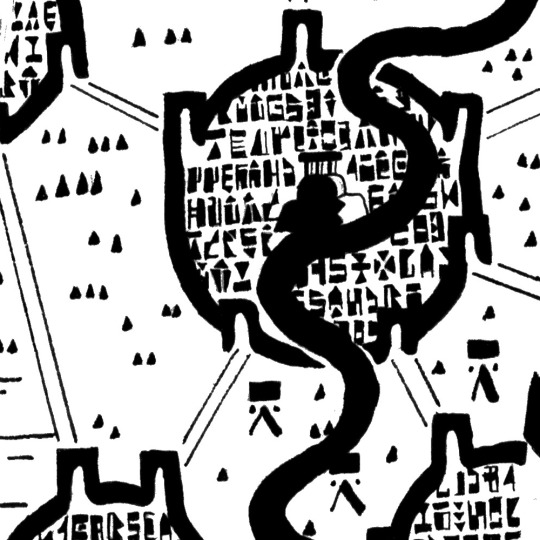

6th and on the right is meant to be a cave painting, with hand-prints and animal figures. The eyes on the top and bottom of the
7th and on the left is stylistically based on maps recovered in ancient times, with an emphasis on features and blocky texturing. The text within the boundaries of the city is a font I'm planning on using in a Monster Hunter project, and is technically in English. (King and Temple are legible in the first couple of lines)
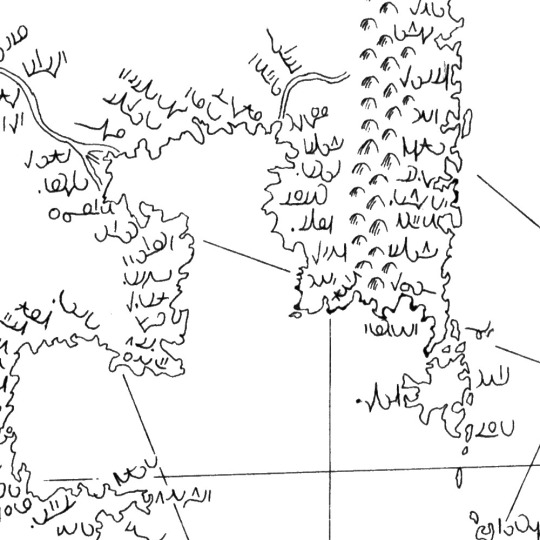
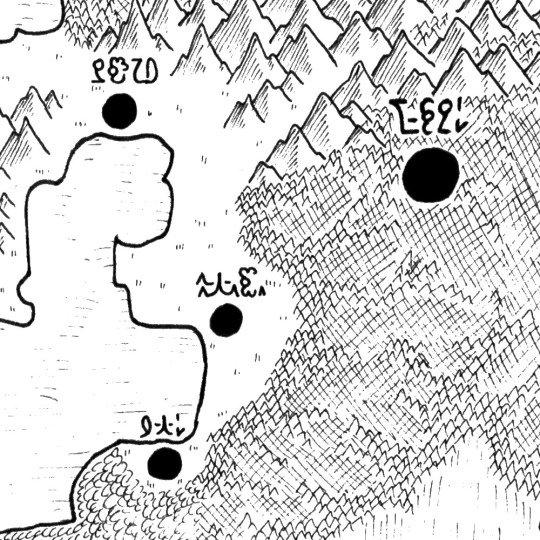
8th and on the right is the standard texturing I used on my PMD maps and features a script based off of my earliest conlang, but is using basically random glyphs. it is meant to be Medieval, and has coastlines which emphasis simple lines and curves.
9th and on the left is a naval map featuring many coastal cities, with their labels written in my main conlang script MAEPS. The coastlines emphasize bays to a major extent, with similarly blocky landmasses as the Medieval map.
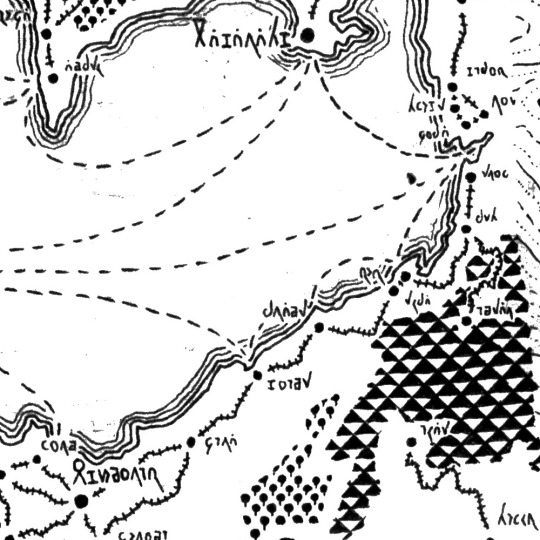
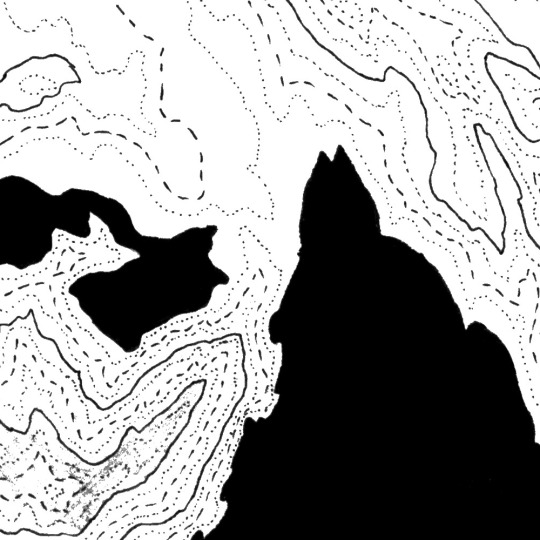
10th and on the right is a topographic map with naturalistic coastlines, which sadly was drawn at the wrong scale for it to look good 😔
11th and on the left is a map drawn to emulate the aesthetics of GIS formatting, in particular the mountain and forest texturing which is cropped by the extent of their polygons. The coastlines continue to be naturalistic. The text is a font I'm planning on using in future pokemon projects and is based off of the font used in the gen 8/9 games. (the larger city in the bottom left corner reads Azumarill since I couldn't think of anything else to use)
30 notes
·
View notes
Text
Thank you for attending today’s Spell Seminar. This will be the first of many lessons explaining the spells and magic of WHA, ranging from the simplest of wall breakers to the wildest of windowways.
Today, we will be discussing one of my personal favorite spells, wall bend.
Spell Seminar Lesson One: The Wall Bend Spell


First seen on pg 27 of chap 14, wall bend is a spell capable of bending and pulling solid walls as if they were cloth. Remarkably, after the spell was first revealed in chapter 14, we wouldn���t see the glyph until chapter 65.
Experienced spell makers may recognize the earth sigil this glyph’s center, as well as the pull signs (the funky arrows) along the glyph’s sides. However, the signs at the top and bottom of thus glyph (highlighted in gold and purple) are unusual. They will be the focus of today’s lesson.
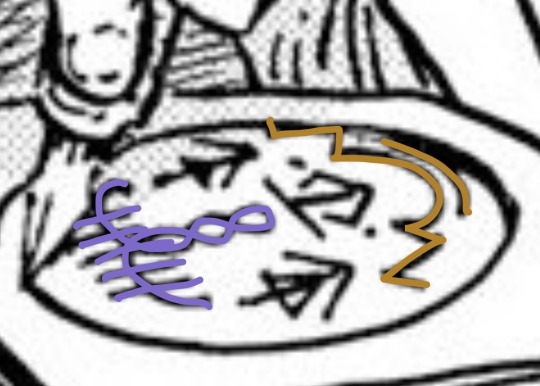
To understand the sign at the top of the spell (furthest away from Qifrey, highlighted in purple), you must first understand the one at the bottom (highlighted in gold)
Compound Signs
The sign drawn in gold is what we call a compound sign. Compound signs are signs composed of several other signs mixed together.
This one consists of three parts: a ribbon sign as the core, a bend sign on each end of the ribbon, and part of an inverted radial sign (strengthen).
Whereas a ribbon sign on it’s own just stretches things into long, soft ribbons, by combining it with bend (and inverted radial to boost its power), it is able to do one of two things; make a single portion of a wall bendable like a sheet of fabric, or allow the portion of wall near the spell to be bent and stretched.
Both of these interpretations are equally valid, but each has different implications as to the function of the bind (purple) sign. I only mentioned one of these interpretations in the twitter version of this lesson, but today, I’ll be going over both of them.
Interpretation One: Unify
Assuming the partial bending interpretation of the compound sign, bind has an important role in holding the wall together.
In this interpretation, bind functions to “bind” the entire wall together into a single cohesive object. This makes it so that, instead of stretching out just a single portion of wall, the spell instead stretches the wall in its entirety as a single cohesive unit.
In this version of the spell, the pull signs function to keep the wall connected to the spell, making use of the wall’s elasticity and stretchiness to do so. Imagine it like a magnet pulling the wall along rather than a direct connection between the spell and the wall.
Bind Interpretation Two: Glue
Assuming that the compound sign already effects the entire wall, then it makes much more sense for the bind sign to function like a glue between the wall and the spell.
In this interpretation, bind physically connects the part of the wall the spell is touching to the spell itself, allowing it to be dragged along with the spell to stretch the wall.
In this version, the pull signs serve simply as aids, helping to make it easier to drag the wall into the desired position and shape rather than just pulling it along as was the case in the other interpretation.
Conclusion
Regardless of which interpretation of bind one day proves to be the right one, this spell is unique for the lessons it can teach us about spell design and for the insights it can give us into magic as a whole. I’ve already designed 2 spells with bind, so it’s safe to say that it has a lot of uses both in universe and for us spell makers. I hope you enjoyed this lesson, and I’ll see you in the next one.
-Chromatic Flare
#atelier of witch hat#tongari booshi no atorie#tongari boushi no atelier#wha#witch hat atelier#wha spells#tbna#δ帽子#magic analysis#spell seminar
75 notes
·
View notes
Note
Hi! I have a question: can broken or fractured bones be seen in MRI scans and CT scans?
Also, when and how do doctors determine whether an MRI or CT scan is needed after an x-ray (in case they didn’t see a problem in the x-ray or unsure if there’s a pathology or not on the x-ray scan)?
Thank you!
Hello!
You can absolutely see broken/fractured bones on both MRI and CT. If we're specifically looking for bony damage, we're more likely to use CT - MRI is the best modality for looking at soft tissue injury, but is far more expensive than CT, so we're not going to use it for any old break!
We use CT to look at complex, 'comminuted' fractures, where the bone has split into multiple fragments, or in other cases where surgeons really need a clear three-dimensional view of the break.
If it's a clean transverse fracture (horizontal snap of a long bone) you probably won't need CT.
However, if you have this shit going on...
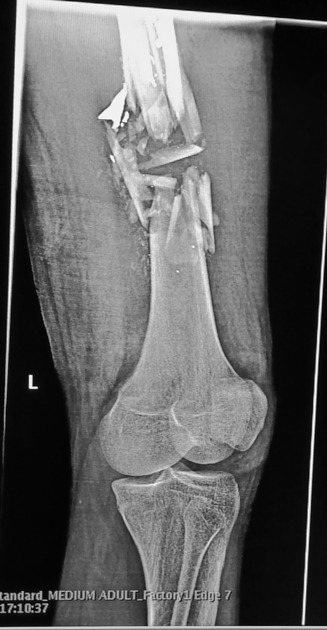
(unstable comminuted fracture of left femur due to gunshot wound, courtesy of radiopedia)
Yeah, it's probably CT time.
Similarly, some fractures can be hidden when using X-ray - particularly intra-articular fractures (breaks within a joint).
Intercondylar fractures of the humerus or fractures of the radial head are a classic example. In these cases, we look at the plain radiograph for other markers - particularly signs of haemarthrosis (bleeding into a joint).
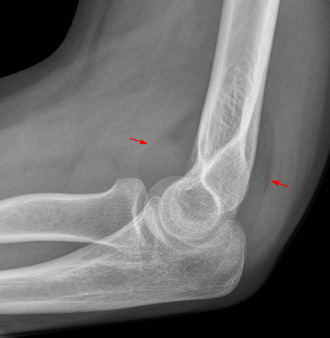
Fat pad sign, on a non-displaced radial head fracture that is otherwise invisible on this elbow radiograph - courtesy of wiki
Can you see the slightly darker, raised areas that the red arrows are pointing to? Those are pads of fat around your elbow joint, which usually aren't nearly so obvious on a radiograph. They've been pushed outwards by soft-tissue swelling and bleeding around the break. If we see these two little 'dark flags', it means there's an injury hidden within the elbow joint itself, which we can't see. So, away to CT the patient goes!
Then we have the fabulous lipohaemarthrosis (the word every first-year student dreads having to say out loud in front of qualified staff). Check this baby out!

Lipohaemarthrosis of the left knee due to a hidden tibial plateau fracture, courtesy of radiopaedia
Look on either side of the patella. See those dark blobs? They're fat. As shown on the elbow image, fat is radiolucent (appears dark on X-ray) in comparison to other soft tissue. Fat also floats on top of blood.
This means, if we lay you down with your knee pointing up, and you happen to have free-floating fat and blood around your joint... the fat bloops up to the top, and you get a clear line between the fat and the blood. This is a very clear sign of intra-articular damage - and, again, you'll be heading to CT to get a three-dimensional look at that hidden fracture.
As for when we would use MRI... If we suspect that you have a serious soft-tissue injury that requires surgery (tears to the anterior cruciate ligament in the knee being the classic example!) that's when you'll get a trip to my favourite magnetic man, Big Boomy Chungus. I can go more into that if you want, but it would probably need its own separate post!
Hope that helps! x
22 notes
·
View notes
Text
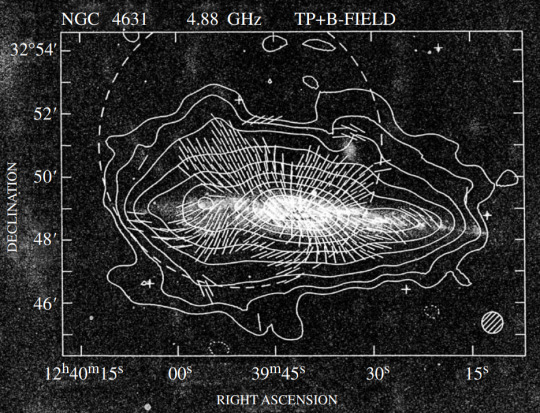
The radial magnetic field around NGC 4631 (Golla and Hummel 1994)
#astrophysics#astroblr#radio astronomy#interstellar medium#magnetic field#physicsblr#extragalactic astrophysics
267 notes
·
View notes
Note
Explain to me dipole selection rules please I beg
Okay, so for a transition between energy eigenstates, there needs to be an exchange of a photon with the correct energy. I'm assuming you know that.
Since photons are waves of the electromagnetic field, they impose an electric moment on charged particles, which in a vast majority of cases can be modeled as a simple dipole moment.
Now here's where the quantum mechanics starts: The dipole moment is expressed as a linear operator, which when applied to the wave function of a particular state gives you back the eigenvalue for the dipole moment of that state. However, since we want to describe the transition between states, and the operator only applies to the ket of the wave function, the bra and the ket which it is nestled in between are of the different states, aka the starting and the final electron state.
The operator applies to the starting state ket, which can then be completed on the left with the final state bra, and then integrated over to obtain the transition dipole moment integral.
This integral will tell you the expectation value for the transition. For the selection rules, you don't actually have to precisely calculate this integral, you just have to find out whether or not it is zero, because if it is, that means you have an impossible transition on your hands.
Depending on your representation, the dipole operator as well as the wave functions will look different, as will the space you integrate over.
So first, find which representation (spatial, spherical, momentum space, etc.) you are working with, how the dipole operator looks for that representation, and then pick the two states you want to see if a dipole transition exists between them.
The tricky part is usually to get the wave function representation right, and then to leverage the symmetries of that function to determine if the value of the integral is zero or not. The representation that i find most common for tasks like this is this one, which separates the wave function into a radial and two angular parts. It is also already conveniently expressed in terms of 3 quantum numbers, that being the main quantum number n, the orbital angular momentum number l, and the magnetic quantum number m.
I am afraid you'll have to learn the quirks and symmetries of the generalized Laguerre polynomials as well as the spherical harmonics, in order to make statements about the transition dipole moment integral. However, once you get a feel for their symmetries and remember in what special cases integrals vanish (like integrating an odd function over a symmetric interval, etc.) you will be able to derive the selection rules.
I know this wasn't a simple and easy answer, but, well, this is quantum mechanics, to be fair. Hope that helped anyway.
#quantum mechanics#dipole selection rules#dipole transition moment integral#dipole operator#physics#ask#laguerre polynomials#spherical harmonics#wave functions
7 notes
·
View notes
Text
Physics Friday: Electricity and Magnetism - why are they together?
Introduction - WTF is this?
So this is the first post which is pretty different to what I've done before on Tumblr, Reddit, etc. But given the fact that I have a bunch of knowledge on the subjects of physics, astronomy, mathematics, and computer science, I might as well ramble about it somewhere ... and what's a better place then a blog format on Tumblr!
So my idea is basically to do a weekly thing where I wax lyrically about some random topic within the realm of STEM, and let the internet people see it ... or not. I'm more interested in just getting the neat and cool ideas out there. So if you're seeing this and you're interested - neat! If you're not ... well I'm still going to do what I normally do and shitpost.
The topics will also vary in education level from primary all the way to university level. I'll try and highlight that in each post!
Some pre-info
Education level: High School (Y11/12) Topic: Electromagnetism (Physics)
Ok it's Physics time
At some point in your long life, maybe in class, maybe perusing the internet, you might've come across the term 'Electromagnetism' and gotten confused. Not because it's a complex word and it's 3 am but more that it's strange to see such an emphasis on a combination of Electricity (circuits, lightning, etc.) and Magnetism (Bar Magnets, etc.) and well, why is that? Why don't we focus on something like gravity and electricity or some other physical phenomenon? This is a question I often came across in high school. I saw all of the equations that related electricity and magnetism with eachother: Ampere's law, Faraday's law, the motor effect, Electromagnetic waves. But what intrinsically ties these two phenomenon together? After all, we know magnetism comes from electrons, and electricity comes. But still - this doesn't seem to complete the gap.
This was a question that a lot of people were concerned with, until Maxwell, Lorentz, and Einstein came along and changed our understanding of electricity, magnetism, and motion.
To figure this out, we won't actually need special relativity, because we can just imagine scenarios in a low-speed limit. But we still require relativity of a more classical variety.
So how does it work?
Consider a wire with a current running through the wire. Electrons are moving through the wire, causing the flow of current.
Now, because of Ampere's law, we know the wire produces a circular magnetic field around it.
Given what we currently know, the act of having a current - an electricity thing, producing a magnetic field, is really odd. But what if we were to introduce some velocity into the equation?
Say we now place an electric charge next to the wire, and it's stationary. Ignoring gravity for a moment, nothing happens. Why? Well because of the lorentz force F = qE + qvB there's nothing to move it. But now let's move this charged object at some speed along the wire, and let's say it's moving at exactly the same speed as the electrons in the wire. Now we have force! The charge begins to move perpendicular to the field and the charge starts flying towards the wire.
But this is a kinda boring explanation from the perspective of someone standing still, looking at the wire and seeing this happen. What if we were to look at things from the perspective of the charged object?
Well, given the rules of relativity, in the charge's perspective, the electrons are actually stationary, so from here - there IS no magnetic field!
So what happens now? Well because we have a straight line of electrons, and these electrons are still, we now have radially pointing electric field emanating from the wire. Because of this electric field - the charge will begin to move towards the wire, coincidentally at the same rate as what we see the observer.
Now look at what we have here. From the perspective of the stationary wire, a magnetic field is produced. From the perspective of the charge, we have an electric field.
The fact of the matter is that the electric and magnetic fields are the same thing - just from different perspectives. A pure magnetic field is just an electric field viewed from a different velocity, and what you may see as an electric field is just a magnetic field but because we're moving relative to it, it now affects us.
How Special Relativity Comes into this
We can represent this effect using another equation:
E' = γ (E+vB)
Where γ is the lorentz factor. This is where the lorentz invariance - special relativity comes into this. This is a direct solution of Maxwell's Equations.
Let's simplify this by removing the γ in a low-velocity limit, and also multiply both sides by an electric charge term q:
qE' = qE + qvB
E' is the electric field in a frame moving at a particular velocity, whereas E and B are the electric and magnetic fields in a different frame of reference.
Notice how both expressions represent the force applied to a charge. This is a representation of the relativistic interpretation of electric and magnetic fields.
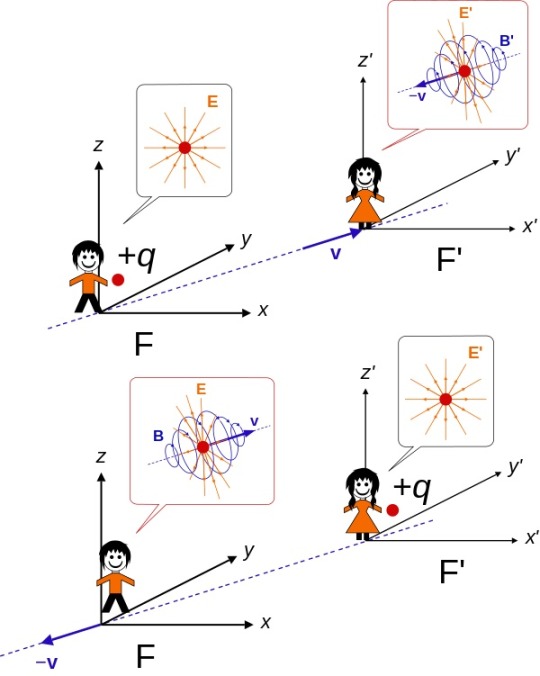
Image Credit: Wikipedia
This image from Wikipedia, it shows the effect I've been talking about but visually. In the top section we have a man standing stationary to an electric charge, which emanates an electric field. From the perspective of the moving woman, the charge produces both a magnetic and electric field.
On the bottom we see the opposite. A stationary man sees a moving charge as having both an electric and magnetic field. But when we move at the same velocity as the charge, the magnetic field disappears and it appears entirely as an electric field.
Conclusion
In conclusion, why electricity and magnetism can be unified is because they are quite literally the same field, but from a different perspective.
Technically speaking, magnetic fields don't exist, they're just electric fields moving at a particular speed. We could also say the exact same about electric fields.
This revelation is what allowed Einstein to simplify Maxwell's equation into just one - using the power of tensors. Because really, the two forces are one in the same!
I very much hope you enjoyed reading this post. I'm going to be doing this every Friday. It's a bit rusty - and you probably had a hard time reading it. Feedback (both positive and negative) is appreciated!
60 notes
·
View notes
Text
youtube
Testing Video of 11KW 1500RPM 5000VAC Three Phase Permanent Magnet Generator (PMG) In this video, we are testing this Three Phase Permanent Magnet Generator (PMG) step by step according to RPM from 100RPM to 1500RPM.
For any queries, please Call or WhatsApp at +919289311243, +919582345931, +918826634990, or +919999467601. Email:- [email protected]
#permanent magnet alternator#permanent magnet alternator manufacturer#permanent magnet generator#permanent magnet generator manufacturer#permanent magnet synchronous generator#low rpm permanent magnet alternator#low rpm permanent magnet generator#axial flux permanent magnet generator#radial flux permanent magnet generator#permanent magnet low rpm alternator#permanent magnet alternator manufacturers#high speed permanent magnet alternators#alternator manufacturer in Delhi#alternator manufacturer in India#generator manufacturer in India#generator manufacturer in Delhi#alternator#generator#generator manufacturer#alternator manufacturer#Youtube
1 note
·
View note
Text

NOAA releases imagery from world's first operational space-based coronagraph
NOAA today shared the first images from the Compact Coronagraph (CCOR-1), a powerful solar telescope onboard the new GOES-19 satellite. CCOR-1, the world's first operational, space-based coronagraph, began observing the sun's corona, the faint outermost layer of the solar atmosphere, on September 19, 2024.
CCOR-1 monitors the corona to forecast coronal mass ejections (CMEs), which are large expulsions of plasma and magnetic fields from the sun that can produce space weather impacts on Earth.
When directed toward Earth, CMEs can cause geomagnetic storms and other types of space weather that can impact satellites, navigation systems like GPS/GNSS, astronaut safety, aviation communications and electric power grids. On Earth, the familiar aurora displays are the visible manifestations of these storms interacting with Earth's upper atmosphere.
CCOR-1 delivers uninterrupted coverage of the corona with a new image every 15 minutes. CCOR-1 uses an occulting disk (the dark blue circle at the center of the video) to eclipse the sun (depicted as the smaller white circle) so we can view the extremely faint corona.
The sun also dazzles with its small and large streamers, bright radial structures along which the solar plasma travels steadily outward. The CME explosions bend and sometimes disrupt the streaming plasma, buzzing past it at speeds of hundreds to thousands of miles per second.
CCOR-1 is the first in a series of NOAA coronagraphs. Similar instruments will be placed on the sun-Earth line and around the sun, as part of NOAA's Space Weather Follow-On and Space Weather Next programs, respectively.
GOES-19 is currently undergoing post-launch testing and checkout of its instruments and systems. After GOES-19 is assigned the operational role as NOAA's GOES East satellite in spring 2025, NOAA's Space Weather Prediction Center will begin using CCOR-1 observations to inform and improve its forecasts and warnings of impending space weather.
6 notes
·
View notes
Text
Radiation Ring Magnet
Radiation Ring Magnet Sintered NdFeB magnetic ring is a new product developed in recent years. It is mainly used in high-performance permanent magnet motors and sensors. In the application of permanent magnet motors, sintered NdFeB magnetic tiles are usually bonded into a ring, which has natural disadvantages: Since the processing of the tile-shaped magnet belongs to special-shaped processing,…

View On WordPress
#high performance ndfeb magnets#high-performance permanent magnet motors#magnet magnetism#Magnet Maker#magnetic effects#magnetic field#magnetic fields#magnetic force#magnetic material#Magnetic Materials#magnetic objects#magnetic properties#Magnetic Ring#Magnetic Sensors#magnetic structures#multi-poles magnetic rings#Multipole Radial Ring magnet#Multipole ring magnets#NdFeB Magnet#NdFeB magnetic ring#NdFeB permanent magnet#NdFeB Ring Magnets#Neodymium iron boron#permanent magnet material#Permanent Magnet Materials#Permanent Magnets#radiation ring magnet#Rare Earth Magnets#rare earth permanent magnet#samarium cobalt
1 note
·
View note
Note
What are most sea crawler meals like?

Every culture has their own distinct dishes, but they mostly look something like this! Radial symmetry is an extremely common motif for sea crawlers, and this extends to their food. Shown here is a popular Daihrut dish: Qhuavan 'nudibranchs' and roe. The spikes are magnetic at the tips, attached to magnetic points on a table. The translucent lid keeps unattended food from floating away.
They're also very decorative! Crawlers are all about extravagancy.
More about food and crawler diets in this older post.
#thank you for the ask!#sea crawlers#speculative biology#alien culture#vivere 44#spec bio#worldbuilding#ask#aliens#my art#have a messy sketch
103 notes
·
View notes
Text
Reference Archived on our website
Introduction: There is a growing interest in the effect of Long-COVID (LC) on cognition, and neuroimaging allows us to gain insight into the structural and functional changes underlying cognitive impairment in LC. We used multimodal neuroimaging data in combination with neuropsychological evaluations to study cognitive complaints in a cohort of LC patients with mild to moderate severity symptoms.
Methods: We conducted a 3T brain magnetic resonance imaging (MRI) study with diffusion tensor imaging (DTI) and functional MRI (fMRI) sequences on 53 LC patients 1.8 years after acute COVID-19 onset. We administered neuropsychological tests to evaluate cognitive domains and examined correlations with Tract-Based Spatial Statistics (TBSS) and resting state.
Results: We included 53 participants with LC (mean age, 48.23 years; 88.7% females). According to the Frascati criteria, more than half of the participants had deficits in the executive (59%) and attentional (55%) domains, while 40% had impairments in the memory domain. Only one participant (1.89%) showed problems in the visuospatial and visuoconstructive domain. We observed that increased radial diffusivity in different white matter tracts was negatively correlated with the memory domain. Our results showed that higher resting state activity in the fronto-parietal network was associated with lower memory performance. Moreover, we detected increased functional connectivity among the bilateral hippocampus, the right hippocampus and the left amygdala, and the right hippocampus and the left middle temporal gyrus. These connectivity patterns were inversely related to memory and did not survive false discovery rate (FDR) correction.
Discussion: People with LC exhibit cognitive impairments linked to long-lasting changes in brain structure and function, which justify the cognitive alterations detected.
#mask up#covid#pandemic#covid 19#wear a mask#public health#coronavirus#sars cov 2#still coviding#wear a respirator#long covid#covid conscious#covid is airborne
14 notes
·
View notes